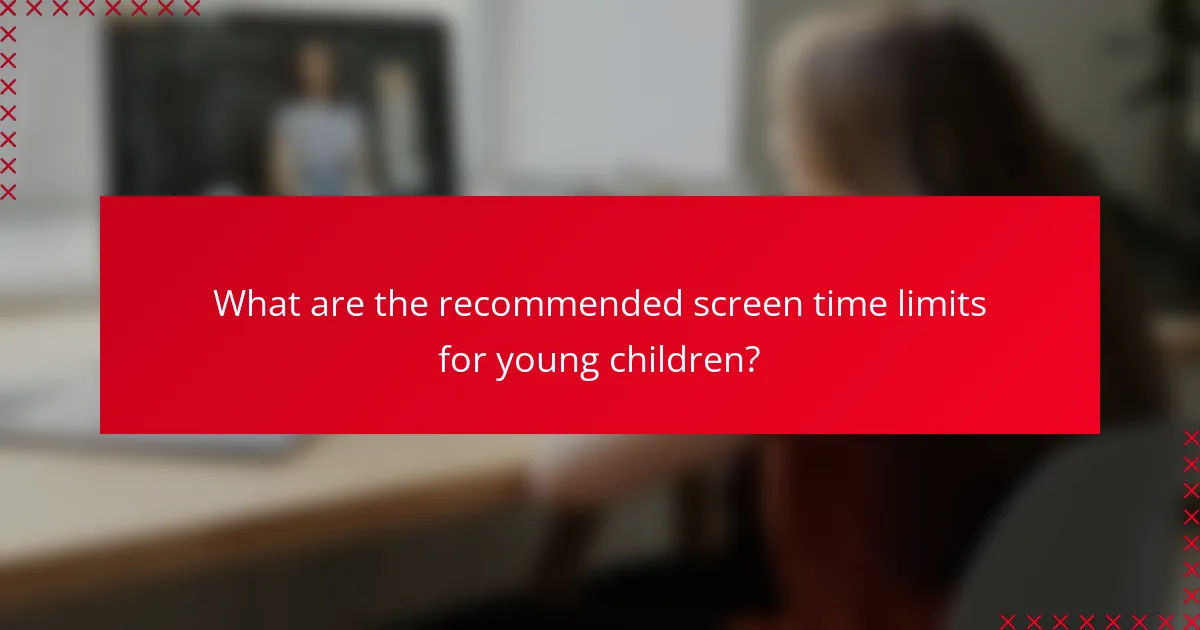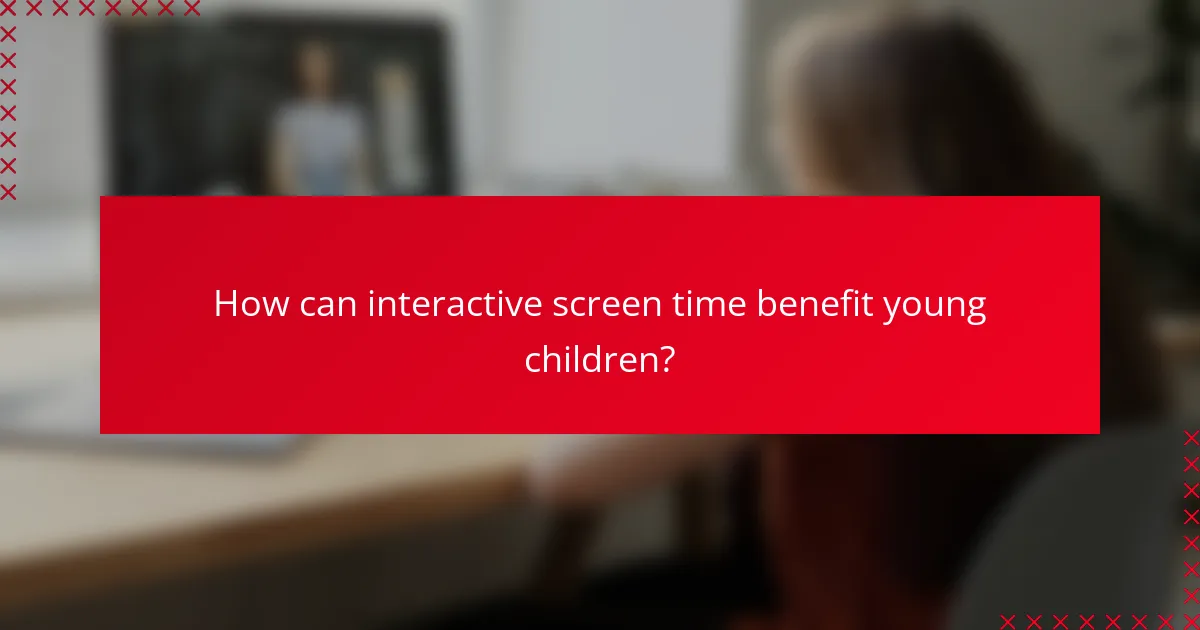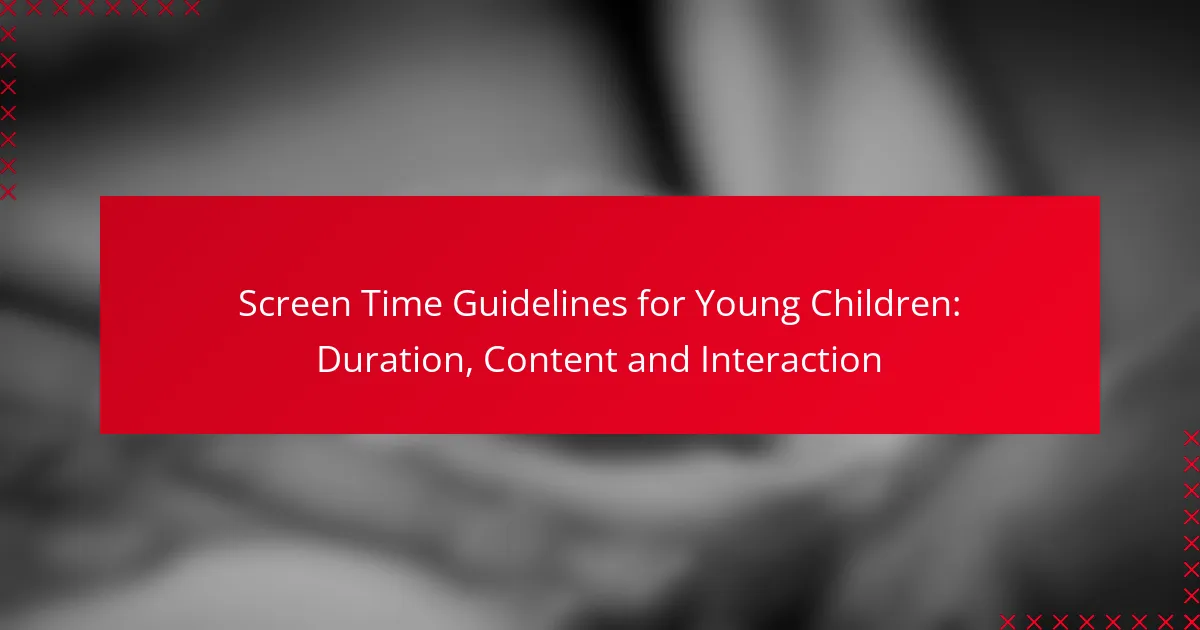Screen time guidelines for young children stress the importance of minimal use, particularly for those under two years old, while advocating for a balanced approach for older kids that includes educational content and parental involvement. Selecting age-appropriate and engaging programming is crucial for fostering learning and development. By setting clear limits and encouraging beneficial interactions, parents can help their children develop healthy screen habits.

What are the recommended screen time limits for young children?
The recommended screen time limits for young children emphasize minimal use, especially for those under two years old. For older children, guidelines suggest a balanced approach that includes educational content and parental interaction.
Age-specific guidelines from the American Academy of Pediatrics
The American Academy of Pediatrics (AAP) provides specific recommendations based on age. For children younger than 18 months, screen time should be avoided, except for video chatting. For children aged 18 to 24 months, parents can introduce high-quality programming, but co-viewing is encouraged to help with understanding.
For children aged 2 to 5 years, the AAP recommends limiting screen time to one hour per day of high-quality programming. Parents should engage with their children during viewing to enhance learning and comprehension. For children aged 6 years and older, consistent limits on screen time are advised to ensure a healthy balance with other activities.
Recommended daily screen time duration
The recommended daily screen time duration varies by age group. For children under 2 years, screen time should be minimal, ideally none aside from video calls. For those aged 2 to 5 years, keeping screen time to about one hour of educational content is advisable.
For children aged 6 years and older, the AAP suggests that parents set consistent limits on the amount of time spent on screens, balancing it with physical activity and sleep. Regular breaks during screen use are also beneficial to prevent fatigue and promote healthy habits.

What types of content are appropriate for young children?
Appropriate content for young children includes educational programming and age-appropriate entertainment that fosters learning and development. Parents should prioritize shows and activities that are designed specifically for their child’s age group, ensuring the content is engaging and beneficial.
Educational content recommendations
Educational content should focus on foundational skills such as literacy, numeracy, and social-emotional development. Programs that encourage interaction, like those that ask questions or prompt children to participate, are particularly effective. Look for content that aligns with early learning standards, such as those set by the National Association for the Education of Young Children (NAEYC).
Examples of highly recommended educational shows include “Sesame Street,” which combines entertainment with lessons on numbers, letters, and social skills, and “Bluey,” which promotes imaginative play and problem-solving. Aim for a mix of screen time that includes interactive apps or games that reinforce these skills.
Age-appropriate entertainment options
For entertainment, choose programs that are specifically designed for young viewers, typically those rated for ages 2-5. Content should be simple, colorful, and engaging, with relatable characters and straightforward storylines. Avoid violent or overly complex themes that can confuse or frighten young children.
Popular age-appropriate shows include “Paw Patrol,” which teaches teamwork and community service, and “Peppa Pig,” which offers light-hearted stories about family and friendship. Limit entertainment screen time to about one hour per day to maintain a healthy balance with other activities like play and reading.

How can parents effectively manage screen time?
Parents can manage screen time by establishing clear limits and encouraging engaging content. Setting boundaries helps children develop healthy habits while ensuring that screen interactions are beneficial and age-appropriate.
Strategies for setting screen time limits
To set effective screen time limits, consider age-appropriate guidelines. For children aged 2 to 5, aim for no more than one hour of high-quality programming each day. For younger children, less is often more, focusing on interactive play instead.
Involve children in the process by discussing why limits are necessary. This can foster understanding and cooperation. Use visual timers or charts to help children see how much time they have left, making the experience more tangible.
Tools for monitoring screen usage
Monitoring screen usage can be facilitated through various tools and apps designed for parents. Many devices come with built-in parental controls that allow you to set time limits and filter content. Explore options like Google Family Link or Apple Screen Time for comprehensive tracking.
Additionally, consider using apps that provide insights into screen time habits. These tools can help identify patterns and encourage discussions about usage. Regularly review screen time reports with your child to promote accountability and adjust limits as necessary.

What are the potential impacts of excessive screen time?
Excessive screen time can lead to various negative effects on young children’s health and development. These impacts can manifest in both physical and mental/emotional domains, influencing their overall well-being and daily functioning.
Effects on physical health
Prolonged screen time is linked to several physical health issues in children, including obesity and poor posture. When children spend excessive hours in front of screens, they often engage in sedentary behavior, which can lead to weight gain and associated health risks.
Additionally, excessive screen exposure can cause eye strain and discomfort, commonly referred to as digital eye strain. Parents should encourage regular breaks and the 20-20-20 rule: every 20 minutes, look at something 20 feet away for at least 20 seconds.
Effects on mental and emotional well-being
High screen time can negatively affect children’s mental and emotional health, contributing to issues like anxiety and depression. Studies suggest that children who spend more time on screens may experience lower levels of happiness and social interaction.
Moreover, exposure to inappropriate or violent content can lead to increased aggression and desensitization. Parents should monitor the content their children consume and prioritize educational and age-appropriate programming to foster positive development.

How can interactive screen time benefit young children?
Interactive screen time can significantly enhance young children’s learning and development by promoting engagement and active participation. When children interact with educational content, they can develop critical thinking skills, creativity, and social interaction abilities.
Engagement through interactive content
Interactive content, such as educational games and apps, captures children’s attention and encourages them to participate actively. This type of engagement can lead to better retention of information compared to passive viewing. For instance, children might learn basic math skills through a game that requires them to solve problems to progress.
It’s essential to choose age-appropriate interactive content that aligns with developmental milestones. Look for apps and games that offer a mix of fun and educational value, ensuring that children remain engaged without becoming overwhelmed.
Benefits of co-viewing with parents
Co-viewing interactive content with parents can enhance the learning experience for young children. When parents participate, they can guide discussions, answer questions, and reinforce concepts, making the experience more meaningful. This shared time also strengthens the parent-child bond.
To maximize benefits, parents should ask open-ended questions about the content and encourage children to express their thoughts. Setting aside specific times for co-viewing can help establish a routine, ensuring that screen time remains a positive and enriching activity.

What are the signs of unhealthy screen time habits?
Unhealthy screen time habits in young children can manifest through various signs, indicating excessive use or inappropriate content. Parents should be vigilant for changes in behavior, mood, and physical health that may stem from too much screen exposure.
Indicators of excessive screen time
Excessive screen time can be identified by several indicators, including prolonged periods of device use without breaks, difficulty in engaging in offline activities, and a preference for screens over social interactions. Children may also exhibit signs of fatigue or irritability after extended screen sessions.
It is generally recommended that children aged 2 to 5 have no more than one hour of high-quality programming each day. Monitoring daily usage can help parents ensure that screen time remains within healthy limits.
Behavioral changes linked to screen exposure
Behavioral changes associated with high screen exposure can include increased aggression, difficulty concentrating, and withdrawal from family activities. Children may also show signs of anxiety or depression, particularly if they are exposed to inappropriate content or excessive gaming.
Parents should observe their child’s reactions after screen time and encourage discussions about what they watch. Setting clear boundaries and promoting alternative activities can help mitigate negative behavioral effects linked to screen use.

What frameworks exist for evaluating screen time content?
Frameworks for evaluating screen time content help parents and caregivers assess the quality and appropriateness of digital media for young children. These frameworks typically focus on educational value, engagement, and the potential for interactive learning.
Criteria for selecting quality digital media
When selecting quality digital media, consider factors such as educational content, age appropriateness, and the potential for interactive engagement. Look for programs that encourage critical thinking and creativity, rather than passive consumption.
Check if the content aligns with developmental milestones. For instance, media that promotes social skills or problem-solving can be beneficial. Avoid content with excessive violence or inappropriate themes.
Resources for parents on screen time evaluation
Parents can access various resources to evaluate screen time content effectively. Websites like Common Sense Media provide reviews and ratings based on age and content type, helping parents make informed decisions.
Additionally, organizations such as the American Academy of Pediatrics offer guidelines and recommendations on screen time, emphasizing the importance of co-viewing and discussing content with children. Utilize these resources to stay updated on best practices for screen time management.

What emerging trends are shaping screen time guidelines?
Emerging trends in screen time guidelines for young children focus on balancing digital engagement with developmental needs. As technology evolves, experts are adapting recommendations to address the impact of various devices and content types on child development.
Impact of new technologies on screen time
New technologies, such as tablets and smartphones, have changed how children interact with screens. These devices often offer interactive content that can enhance learning but may also lead to increased screen time. Parents should consider the quality of content, opting for educational apps and programs that promote engagement rather than passive consumption.
Moreover, the rise of streaming services has shifted viewing habits, with children spending more time on-demand rather than scheduled programming. This flexibility can be beneficial, but it also requires parents to set boundaries to prevent excessive use.
Future research directions in child screen time studies
Future research will likely explore the long-term effects of screen time on cognitive and social development in children. Studies may focus on how different types of content influence behavior and learning outcomes, as well as the role of parental involvement in mediating screen use.
Additionally, researchers are expected to investigate the impact of emerging technologies, such as virtual reality and augmented reality, on children’s screen time habits. Understanding these dynamics will help refine guidelines and support parents in making informed decisions about their children’s media consumption.
